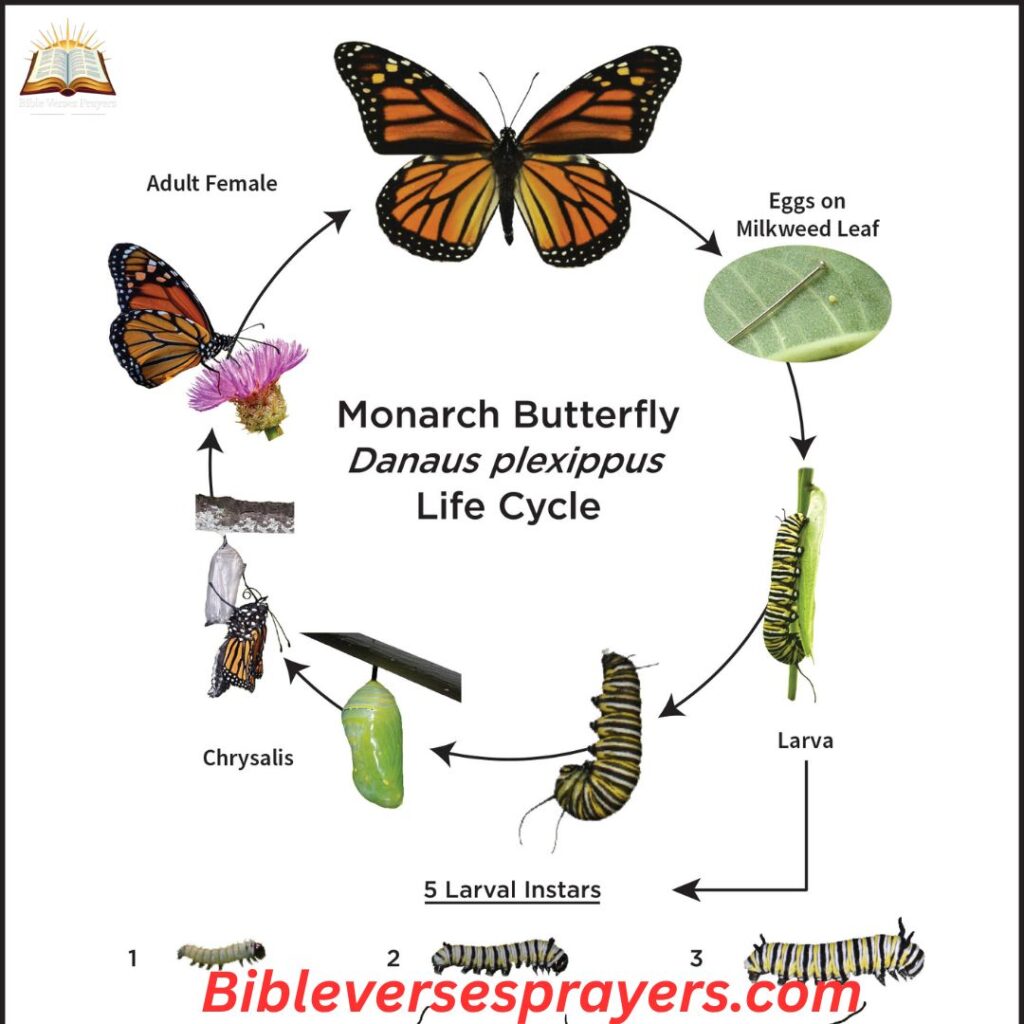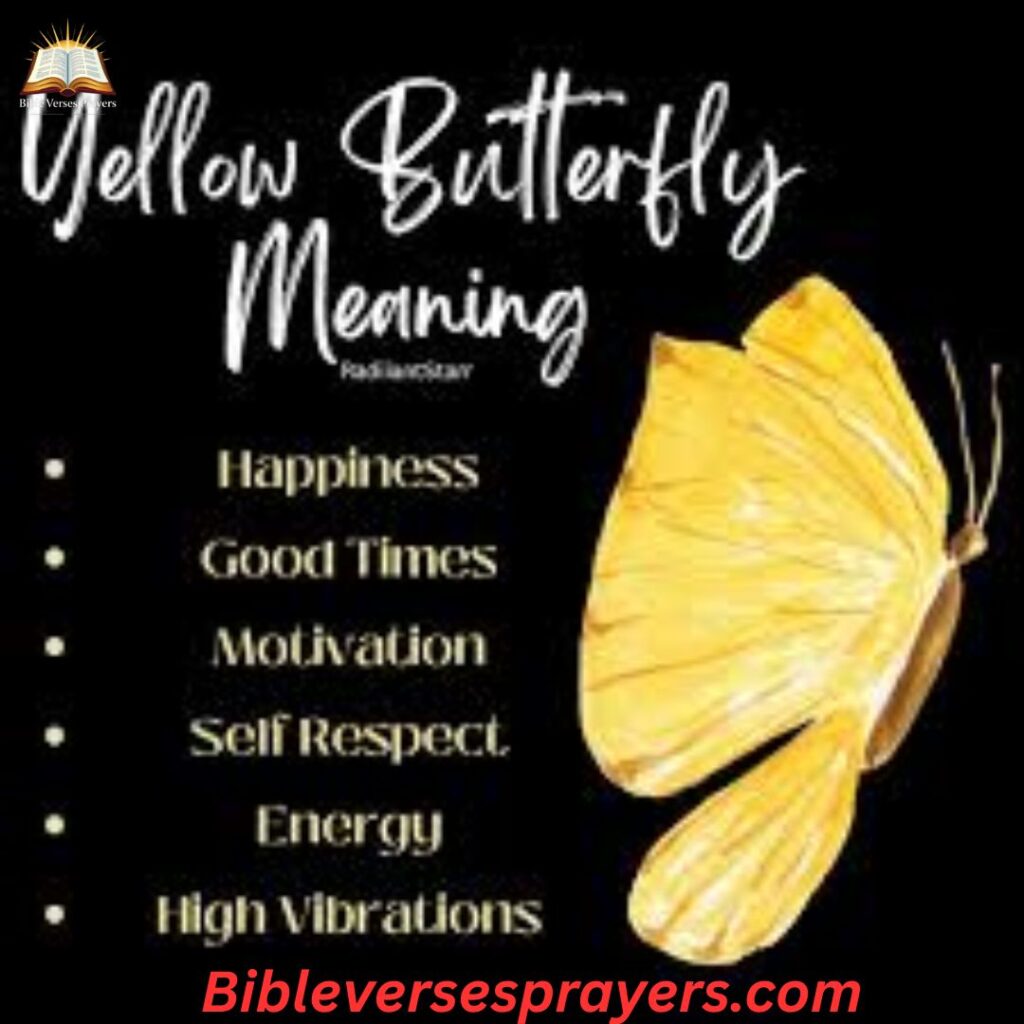A yellow butterfly isn’t just a pretty sight it carries deep spiritual meaning. Its bright wings symbolize light, joy, and God’s presence.
Though butterflies aren’t directly mentioned in the Bible, their transformation perfectly mirrors spiritual rebirth. The yellow butterfly reminds us of hope, renewal, and the beauty of God’s promise to make all things new.
Where is Butterfly Written in the Bible?
The word “butterfly” does not appear in any translation of the Bible. This is not surprising, as the ancient Hebrew and Greek languages of Scripture didn’t have a specific term for butterflies as we know them today. The biblical writers lived in an era where creatures were often grouped into broader categories.
However, the absence of the specific word doesn’t diminish the spiritual significance of the butterfly’s symbolism. Throughout Scripture, God uses His creation to reveal spiritual truths. Jesus Himself pointed to birds, flowers, seeds, and sheep to illustrate Kingdom principles. Similarly, the butterfly’s remarkable transformation provides a living parable of spiritual rebirth.
The Bible does mention various insects and flying creatures. Leviticus 11:20-23 discusses “flying insects that walk on all fours,” and some scholars believe butterflies and moths would fall into the broader category of winged creatures that God created on the fifth day (Genesis 1:20-21).
The Lifecycle of a Butterfly

Understanding the butterfly’s lifecycle is essential to grasping its spiritual symbolism. This transformation process, called metamorphosis, contains four distinct stages that beautifully parallel the Christian journey:
- Stage 1: The Egg – The butterfly begins as a tiny egg, often no larger than a pinhead. This represents potential and promise, much like the “seed” of faith planted in our hearts. “For you have been born again, not of perishable seed, but of imperishable, through the living and enduring word of God” (1 Peter 1:23).
- Stage 2: The Caterpillar (Larva) – The egg hatches into a caterpillar whose primary purpose is to eat and grow. This stage represents our earthbound existence before encountering Christ—focused on earthly needs, crawling close to the ground, unable to see the bigger picture. We live according to our fleshly nature, consumed with worldly concerns.
- Stage 3: The Chrysalis (Pupa) – The caterpillar forms a chrysalis and enters what appears to be death. Inside this cocoon, the caterpillar’s body completely dissolves into a liquid substance before being reformed into something entirely new. This is the most profound stage spiritually, representing death to self and transformation in Christ. “Therefore, if anyone is in Christ, the new creation has come: The old has gone, the new is here!” (2 Corinthians 5:17).
- Stage 4: The Butterfly (Adult) – The butterfly emerges—no longer earthbound, but capable of flight. Its entire purpose and appearance have changed. It moves from darkness into light, from crawling to soaring, from consuming leaves to sipping nectar from beautiful flowers. This represents the resurrected life in Christ, where we are no longer slaves to earthly appetites but free to soar in the Spirit.
Butterfly Symbolism
In Christian symbolism throughout history, the butterfly has represented:
- Resurrection and New Life – The butterfly’s emergence from the chrysalis has been used since the early church as a symbol of Christ’s resurrection and the believer’s new life. Just as Jesus emerged from the tomb transformed and glorified, we emerge from spiritual death into resurrection life.
- Transformation and Sanctification – Romans 12:2 calls us: “Do not conform to the pattern of this world, but be transformed by the renewing of your mind.” The Greek word for “transformed” is metamorphoo, from which we get “metamorphosis.” God calls us to undergo the same radical transformation as the butterfly.
- Freedom from the Old Nature – The caterpillar cannot imagine flight while crawling on the ground. Similarly, before salvation, we cannot comprehend the freedom Christ offers. “So if the Son sets you free, you will be free indeed” (John 8:36).
- The Soul’s Journey – Early Christians saw the butterfly as representing the soul released from the body at death, flying free to be with Christ. Paul expressed this hope: “We are confident, I say, and would prefer to be away from the body and at home with the Lord” (2 Corinthians 5:8).
- Beauty from Ashes – God promises to bring beauty from our brokenness. Isaiah 61:3 speaks of receiving “a crown of beauty instead of ashes.” The butterfly demonstrates this divine principle—from a lowly caterpillar comes a creature of exquisite beauty.
Types of Butterflies and Their Meaning
While Scripture doesn’t specify butterfly types, we can examine how different colored butterflies have been interpreted spiritually by believers throughout history:
Brown Butterfly Meaning
Brown butterflies, with their earth-toned wings, symbolize groundedness and humility. They remind us to stay rooted in God’s Word while undergoing transformation. Brown represents the soil from which we came—”The LORD God formed the man from the dust of the ground” (Genesis 2:7)—and calls us to remain humble before our Creator.
Spiritually, brown butterflies may signify:
- Stability in faith – Building your life on the solid rock of Christ
- Humility and servanthood – Remembering our humble origins
- New opportunities emerging – Good things growing from humble beginnings
- Connection to God’s creation – Appreciating the natural world He made
Red Butterfly Meaning
Red is the color of blood, sacrifice, and passionate love throughout Scripture. A red butterfly carries powerful symbolism:
- The blood of Christ – “The blood of Jesus, his Son, purifies us from all sin” (1 John 1:7)
- Divine love and passion – God’s consuming love for His people
- Spiritual warfare – The victory purchased through Christ’s sacrifice
- Martyrdom and sacrifice – The ultimate witness of laying down one’s life
Red butterflies remind us that transformation comes at a cost. Christ paid the price with His blood, and we’re called to “offer your bodies as a living sacrifice” (Romans 12:1).
Orange Butterfly Meaning
Orange combines the energy of red with the joy of yellow. Orange butterflies symbolize:
- Enthusiasm and zeal for God – “Never be lacking in zeal, but keep your spiritual fervor, serving the Lord” (Romans 12:11)
- Creativity and new ideas – The creative power of the Holy Spirit
- Encouragement and warmth – Bringing hope to others
- Harvest and fruitfulness – The autumn colors of abundant blessing
Orange butterflies call us to passionate, joyful service in God’s Kingdom, celebrating the creative diversity of His people and purposes.
Cabbage Butterfly Meaning
The common cabbage white butterfly (Pieris rapae) is one of the most widespread butterflies. Despite being considered a garden pest, it carries spiritual lessons:
- God uses the ordinary – God doesn’t need extraordinary people; He transforms ordinary lives
- Persistence and determination – These butterflies are survivors, adapting to many environments
- Unexpected blessings – Beauty can emerge from the most common circumstances
- Humility in service – Not seeking recognition but faithful in small things
Jesus often used common things to illustrate profound truths—seeds, coins, fish. The cabbage butterfly reminds us that God’s transforming power works in everyday lives.
Black Butterfly Meaning
Black butterflies are rare and striking. In biblical symbolism, black can represent:
- Mystery and the unknown – “Now we see only a reflection as in a mirror; then we shall see face to face” (1 Corinthians 13:12)
- Death to self – Dying to our old nature so Christ can live through us
- Spiritual warfare – Darkness that must be overcome by light
- Deep transformation – The darkest night before the dawn
- Protection – Being hidden in Christ during trials
While black sometimes represents sin or darkness in Scripture, in the context of a butterfly—a creature of transformation—it can symbolize the death that must occur before resurrection. “I have been crucified with Christ and I no longer live, but Christ lives in me” (Galatians 2:20).
White Butterfly Meaning
White is the color of purity, holiness, and righteousness throughout Scripture. White butterflies symbolize:
- Purity and innocence – Washed clean by the blood of the Lamb
- Righteousness in Christ – Clothed in His righteousness (Isaiah 61:10)
- Angels and heavenly messengers – Divine presence and guidance
- New beginnings – A fresh start, sins forgiven and forgotten
- Peace and surrender – Resting in God’s perfect will
“Though your sins are like scarlet, they shall be as white as snow” (Isaiah 1:18). White butterflies remind us of the complete cleansing available through Christ’s sacrifice.
Monarch Butterfly Meaning
The Monarch butterfly is perhaps the most recognized butterfly, known for its incredible migration journey. Spiritually, Monarchs represent:
- Royalty in Christ – We are children of the King, royal priests (1 Peter 2:9)
- Endurance and faith – Their 3,000-mile migration mirrors our faith journey
- Divine guidance – Monarchs navigate by instinct; we’re led by the Holy Spirit
- Community and legacy – Multiple generations complete the migration cycle
- Trust in God’s timing – They know when to transform and when to fly
The Monarch’s journey from caterpillar to butterfly, followed by an epic migration, illustrates the Christian life—transformed by Christ, then embarking on a faith journey that requires complete trust in God’s guidance.
Yellow Butterfly Meaning
The yellow butterfly holds special significance in spiritual interpretation. Yellow is consistently associated with light, glory, joy, and divine presence throughout Scripture:
- Divine Presence and Glory – Yellow and gold represent God’s glory. When Moses encountered God on Mount Sinai, “the glory of the LORD looked like a consuming fire” (Exodus 24:17). The New Jerusalem is described with streets of gold (Revelation 21:21). A yellow butterfly can symbolize God’s presence drawing near, a reminder that He is with you.
- Hope and New Beginnings – Yellow is the color of sunrise, of light breaking through darkness. “The rising sun will come to us from heaven to shine on those living in darkness” (Luke 1:78-79). Yellow butterflies bring messages of hope, promising that no matter how dark the night, morning is coming.
- Joy and Celebration – Yellow reflects the joy of the Lord, which is our strength (Nehemiah 8:10). These butterflies remind us to rejoice always, to find reasons for gratitude even in difficult seasons. Their bright wings declare that joy is a choice and a gift from God.
- Spiritual Enlightenment – Jesus declared, “I am the light of the world” (John 8:12). Yellow butterflies symbolize spiritual illumination—understanding God’s Word, receiving divine wisdom, and walking in His truth. They represent moments when Scripture suddenly becomes clear, when the Holy Spirit opens our eyes to see what we couldn’t before.
- Faith and Trust – The bright yellow color represents childlike faith and trust in God’s provision. “Look at the birds of the air; they do not sow or reap or store away in barns, and yet your heavenly Father feeds them” (Matthew 6:26). Yellow butterflies call us to trust God completely.
- Creativity and God’s Glory – Yellow represents the creative power of God, who paints the world with brilliant colors. A yellow butterfly is a reminder that you’re created in His image, called to create, innovate, and bring beauty into the world.
What Yellow Butterfly Symbolizes Spiritually?

When a yellow butterfly crosses your path, consider these spiritual interpretations:
- God’s Encouragement – Like a divine “thumbs up,” a yellow butterfly can be God’s way of saying, “I see you, I’m with you, keep going.” In moments of doubt or weariness, this bright creature serves as a tangible reminder of His presence.
- Answered Prayer – Sometimes yellow butterflies appear at significant moments, confirming that God has heard your prayers. While we shouldn’t seek signs, God graciously provides confirmations when we need them most.
- Season of Joy Approaching – The appearance of a yellow butterfly may signal that a season of difficulty is ending and joy is coming. After winter comes spring, after tears comes dancing (Psalm 30:5).
- Call to Share the Gospel – Yellow represents light, and we’re called to be lights in the darkness. A yellow butterfly might be prompting you to share the hope of Christ with someone who desperately needs it.
- Reminder of Resurrection Life – The yellow butterfly’s transformation reminds you that you’re not who you used to be. The old is gone, the new has come. You’re living in resurrection power.
- Divine Appointment – When you see a yellow butterfly, pause and pray. Ask God if there’s something He wants to speak to your heart, someone He wants you to reach out to, or some action He’s calling you to take.
What Are the Lessons Learned from the Life of a Butterfly as Believers?
The butterfly’s lifecycle teaches us profound spiritual truths:
1. Transformation Requires Surrender
The caterpillar doesn’t just add wings to its existing form—it must completely dissolve and be reformed. Similarly, true spiritual transformation isn’t about self-improvement; it’s about dying to self so Christ can live through us. “I have been crucified with Christ and I no longer live, but Christ lives in me” (Galatians 2:20).
Lesson: Stop trying to fix your old nature. Instead, surrender completely to God’s transforming work.
2. The Cocoon Stage Is Essential
The chrysalis appears to be a dark, isolated place where nothing is happening. Yet inside, the most miraculous transformation is occurring. Our difficult seasons—times of waiting, silence, or isolation—are often when God does His deepest work in us.
Lesson: Don’t despise the waiting seasons. God is working even when you can’t see it. “Let perseverance finish its work so that you may be mature and complete” (James 1:4).
3. You Can’t Rush the Process
If you try to help a butterfly emerge from its chrysalis, you’ll actually harm it. The struggle to break free is what strengthens its wings for flight. Similarly, we can’t rush God’s timing in our transformation.
Lesson: Trust God’s timing. The struggles you face are developing the spiritual strength you’ll need for your destiny. “He has made everything beautiful in its time” (Ecclesiastes 3:11).
4. Your Past Doesn’t Define Your Future
The caterpillar lives one way; the butterfly lives completely differently. Your past sins, failures, and limitations don’t determine your future. God specializes in creating new things from old.
Lesson: Stop defining yourself by your past. You are who God says you are—a new creation, holy and dearly loved. “Forget the former things; do not dwell on the past. See, I am doing a new thing!” (Isaiah 43:18-19).
5. Freedom Requires Leaving the Old Behind
The butterfly cannot return to being a caterpillar. Once transformed, it must embrace its new identity. We cannot live the resurrected life while clinging to our old ways.
Lesson: Let go of your old life completely. “Anyone who loves their life will lose it, while anyone who hates their life in this world will keep it for eternal life” (John 12:25).
6. Your Transformation Brings Beauty to the World
Butterflies pollinate flowers as they feed, bringing life and beauty wherever they go. When you’re transformed by Christ, you naturally bless others and spread the Gospel.
Lesson: Your transformation isn’t just for you—it’s for everyone you’ll touch. “You are the light of the world. A town built on a hill cannot be hidden” (Matthew 5:14).
7. Wings Are for Flying, Not Displaying
Butterflies don’t admire their wings in mirrors—they use them to fly. God transforms us not so we can be admired, but so we can fulfill our purpose.
Lesson: Use your gifts and transformation to serve God’s Kingdom, not to build your own reputation. “Each of you should use whatever gift you have received to serve others” (1 Peter 4:10).
Prayer
Heavenly Father,
Thank You for the beautiful picture of transformation You’ve painted in the butterfly. Just as the caterpillar becomes something entirely new, I thank You for making me a new creation in Christ Jesus.
Lord, I surrender to Your transforming work in my life. I acknowledge that I cannot change myself—only You can remake me from the inside out. Help me to trust You during the “cocoon seasons” when I feel hidden, when nothing seems to be happening, when I cannot see the purpose in my waiting.
Father, give me the courage to die to my old self completely. I release my past, my failures, my former identity, and every limitation I’ve placed on myself. I choose to embrace who You say I am—holy, beloved, redeemed, and transformed by Your power.
Like the yellow butterfly that soars in joy and reflects Your glory, help me to live in the freedom of resurrection life. Fill me with Your joy, illuminate my path with Your truth, and use me to bring hope and light to those living in darkness.
Thank You that You make all things beautiful in their time. Thank You that You waste nothing—not my struggles, not my waiting, not even my mistakes. You are working all things together for my good and Your glory.
May my life be a testimony to Your transforming power. May others see the change in me and be drawn to You, the One who makes all things new.
In Jesus’ mighty name, Amen.
Final Thoughts
The yellow butterfly, though not mentioned in Scripture, serves as a living sermon about God’s transforming power. Its brilliant wings proclaim the joy of salvation, the hope of resurrection, and the beauty that emerges when we surrender to God’s refining process.
When you see a yellow butterfly, let it be a reminder: You are not who you were. The old has gone, the new has come. You have been transformed by the renewing of your mind, and you are being conformed to the image of Christ daily.

David Smith is an experienced SEO expert and the founder of BibleVersesPrayers.com, a platform dedicated to sharing the truth, hope, and power of God’s Word through meaningful Bible verses and heartfelt prayers.






